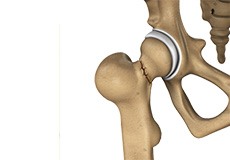Trauma
Orthopaedic Trauma is the branch of surgical medicine that treats severe injuries of the musculoskeletal system. In addition to bone fractures or breaks, ligament, tendon, nerve, muscle, and skin injuries fall into this area of care. These injuries can range from a single broken bone to multiple fractures which can be life threatening. The mechanism of such injuries can occur from a simple fall during activities around the home, an injury incurred at work, or as a result of a motor vehicle accident.
Musculoskeletal trauma injuries usually fall into four categories: long bone fractures, fractures that involve the joint, pelvic fractures, and fractures that involve the hand or foot. More than 50% of patients admitted to Level I Trauma Centers experience musculoskeletal injuries. Due to the complex nature of these problems, a patient's care needs to be coordinated between multiple fields of medicine.
Unfortunately, some severe injuries may not heal properly or may develop an infection. An orthopaedic trauma specialist will identify and provide a patient with healing programs designed to assist their body in recovering from these types of injuries.
- Upper Extremity
- Lower Extremity
- Problem Fractures

Humerus Fracture
The upper arm is made up of the humerus bone. The head of the humerus fits into a shallow socket in your scapula (shoulder blade) to form the shoulder joint. The humerus narrows down into a cylindrical shaft and joins at its base with the bones of the lower arm to form the elbow joint.

Elbow Fractures
Elbow fractures may occur from trauma, resulting from various reasons: a fall on an outstretched arm, a direct blow to the elbow or an abnormal twist to the joint beyond its functional limit.

Olecranon Fracture
Olecranon fractures are described as a break in the bony tip of the elbow that sticks out when you bend your arm. A fracture of the olecranon bone can be very painful and make motion of the elbow difficult or impossible.

Adult Forearm Fracture
The forearm is made up of 2 bones, namely the radius and ulna. The primary function of your forearm is rotation i.e., the ability to turn your palms up and down. The fracture of the forearm affects the ability to rotate your arm, as well as bend and straighten the wrist and elbow.

Forearm Fractures in Children
The radius (bone on the thumb side) and ulna (bone on the little-finger side) are the two bones of the forearm. Forearm fractures can occur near the wrist, near the elbow or in the middle of the forearm. Apart from this, the bones in children are prone to a unique injury known as a growth plate fracture.

Wrist Fracture
The wrist is comprised of two bones in the forearm, the radius and ulna, and eight tiny carpal bones in the palm. The bones meet to form multiple large and small joints. A wrist fracture refers to a break in one or more of these bones.

Fractures of the Hand and Fingers
The hand is one of the most flexible and useful parts of our body. Because of overuse in various activities, the hands are more prone to injuries, such as sprains and strains, fractures and dislocations, lacerations and amputations while operating machinery, bracing against a fall and during sports.

Ankle Fracture
The ankle joint is composed of three bones: the tibia, fibula, and talus, which articulate together. The ends of the fibula and tibia (lower leg bones) form the inner and outer malleolus, which are the bony protrusions of the ankle joint that you can feel and see on either side of the ankle.

Femur Fracture
The femur or thigh bone is the longest and strongest bone in the body, connecting the hip to the knee. A femur fracture is a break in the femur. The distal femur is the lower part of the thigh bone which flares out like an upside-down funnel and its lower end is covered by a smooth, slippery articular cartilage that protects and cushions the bone during movement.

Hip Fracture
Hip fractures involve a break that occurs near the hip in the upper part of the femur or thigh bone. The thigh bone has two bony processes on the upper part - the greater and lesser trochanters. The lesser trochanter projects from the base of the femoral neck on the back of the thigh bone.

Knee Fractures
A knee fracture is a broken bone or a crack in or around the joint of the knee. This can involve the tibia (shin bone), the kneecap (patella), or femur (thighbone) where they connect with the knee.

Pilon Fracture
The tibia and fibula are long shin bones, which articulate with the thighbone on one end and ankle joint at the lower end. The part of the tibia that articulates with the talus (ankle bone) is called the tibial plafond or pilon. Fractures of the tibial plafond are rare, occurring as a result of a fall from a height or a motor vehicle accident that forces the ankle up against the tibia, often causing the bone to shatter.

Tibia Fracture
The lower leg is made up of two long bones called the tibia and fibula that extend between the knee and ankle. The tibia or shinbone is the larger of the two bones. It bears most of the body’s weight and helps form the ankle joint and knee joint.

Pubic Rami Fractures
Coming soon

Acetabular Fracture
Coming soon

Avulsion Fracture
Coming soon

Fibula Fracture
Coming soon

Pelvic Fracture
A pelvic fracture is a condition that occurs due to the breakage of the pelvic bone. It may cause damage to the internal organs, nerves and blood vessels associated with the pelvic region.

Non-union
A fracture is a break in the bone that occurs when extreme force is applied. Treatment of fractures involve the joining of the broken bones either by immobilizing the area and allowing the bone to heal on its own, or surgically aligning the broken bones and stabilizing it with metal pins, rods or plates.


Pediatric Fractures
Fractures are more common in children due to their activities as well as their bone properties. Children are more active than adults and management of fractures in them also differs as compared to that in adults. Fractures occur when the bone is subjected to excessive stress than normal.

Bone Infection (Osteomyelitis)
Bone infection or osteomyelitis is a serious medical condition that needs immediate medical attention. Infection may occur due to an open fracture or surgery or infection in one area of the body may spread to the bone via the bloodstream.

Geriatric/Fragility Fractures
Coming soon




